IBM POWER7 User Manual
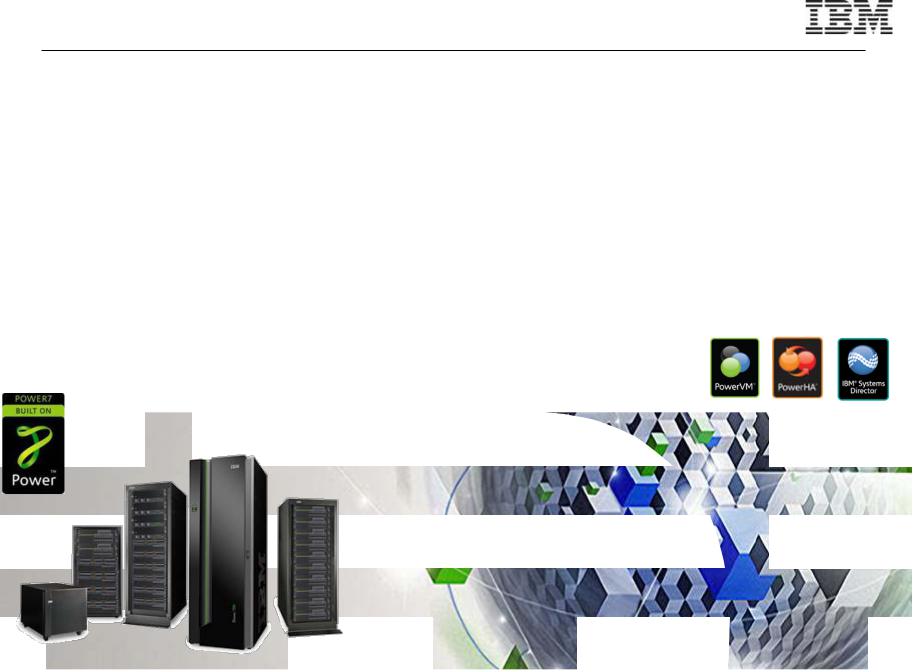
POWER7
Technology Insight
Wayne Huang
Fang Shu Xin
IBM CONFIDENTIAL – FOR IBM AND BP USE ONLY – NOT FOR DISCLOSURE TO CUSTOMERS
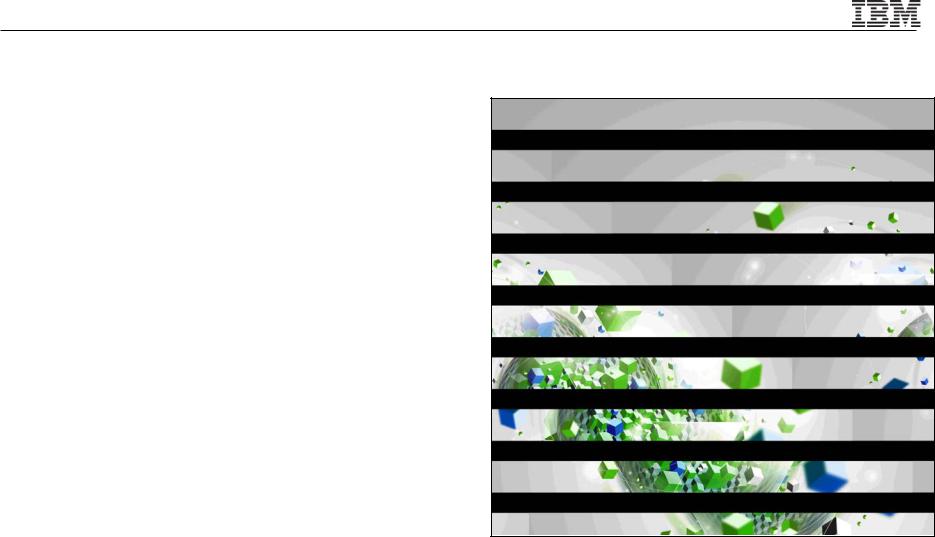
IBM Power Systems
Agenda….
POWER7 Product Family POWER7 Processor Active Memory Expansion POWER7 TPMD
OS Support on POWER7 POWER7 Servers
Power 750
Power 755
Power 770
Power 780
RAS Update
I/O Update
Summary
Power your planet
© 2010 IBM Corporation
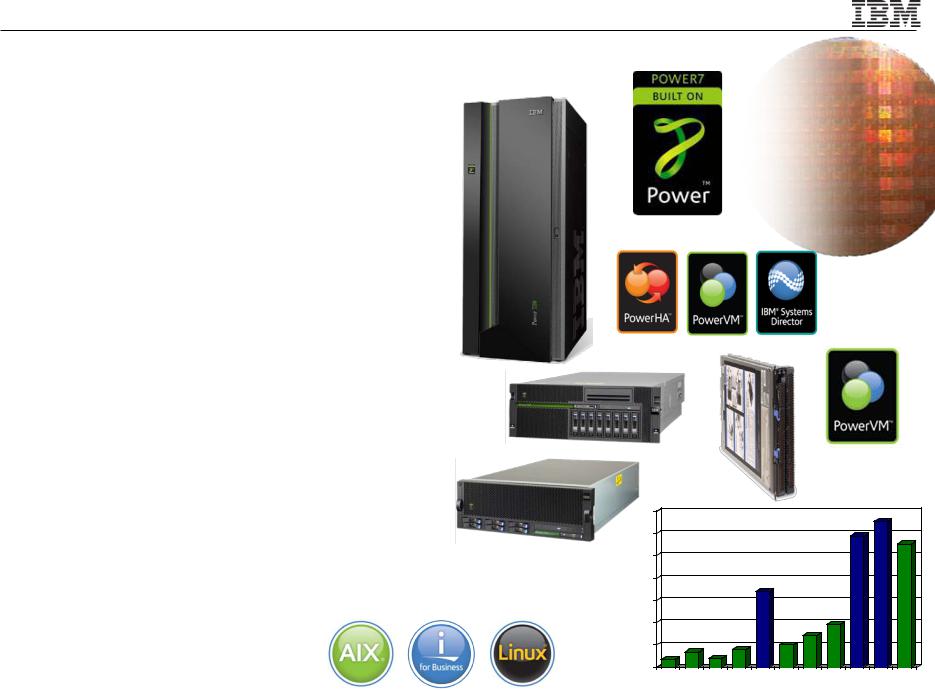
IBM Power Systems
POWER7 System Highlights
Balance System Design
Cache, Memory, and IO
POWER7 Processor Technology
6th Implementation of multi-core design
On chip L2 & L3 caches
POWER7 System Architecture
Blades to High End offerings
Enhances memory implementation
PCIe, SAS / SATA
Built in Virtualization
Memory Expansion
VM Control
Green Technologies
Processor Nap & Sleep Mode
Memory Power Down support
Aggressive Power Save / Capping Modes
Availability
Processor Instruction Retry
Alternate Process Recovery
Concurrent Add & Services
Power your planet
700 |
|
|
|
|
|
|
|
|
|
|
600 |
|
|
|
|
|
|
|
|
|
|
500 |
|
|
|
|
|
|
|
|
|
|
400 |
|
|
|
|
|
|
|
|
|
|
300 |
|
|
|
|
|
|
|
|
|
|
200 |
|
|
|
|
|
|
|
|
|
|
100 |
|
|
|
|
|
|
|
|
|
|
0 |
|
|
|
|
|
|
|
|
|
|
JS23 |
JS43 |
520 |
550 |
750 |
560 |
570/16 |
570/32 |
770 |
780 |
595 |
© 2010 IBM Corporation
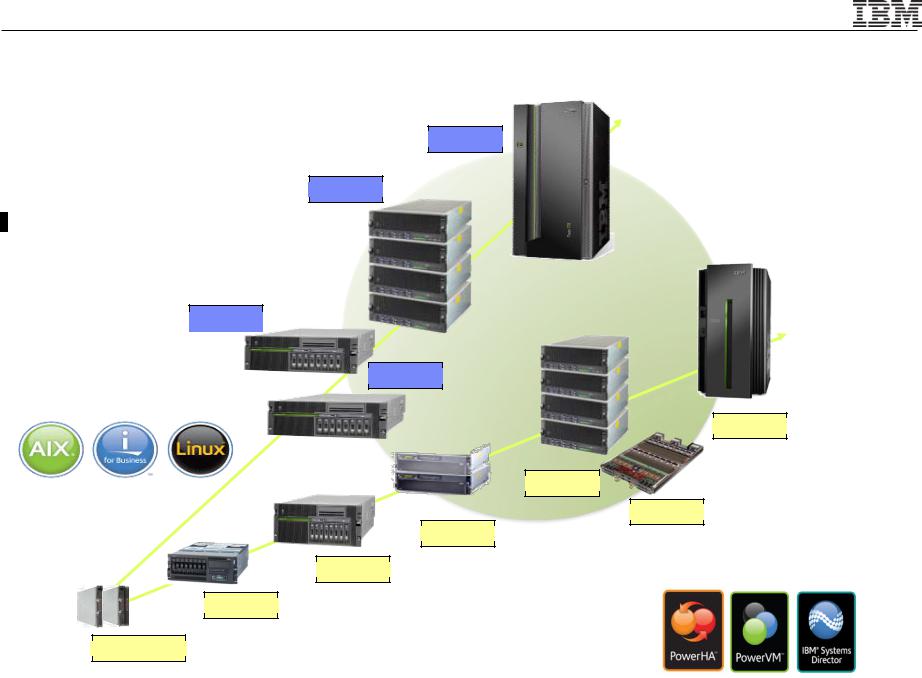
IBM Power Systems
Power 2010
Power7
Power 750 (8,16,32 Core)
Power 755 (32 Core) for HPC
Power 770 (12,24,36,48 Core)
Power 780 (16,32,48,64 Core)
POWER6 2010
Power 520, Blades
Power 550
Power 560
Power 570
|
|
|
Power 575 |
Power 750 |
|
|
|
|
Power 595 |
|
|
Power 520
Power Blades
Power your planet
Power 7 Systems
Power 780
Power 770
Power 6 Systems
Power 755
Power 595
Power 570
Power 575
Power 560
Power 550
© 2010 IBM Corporation
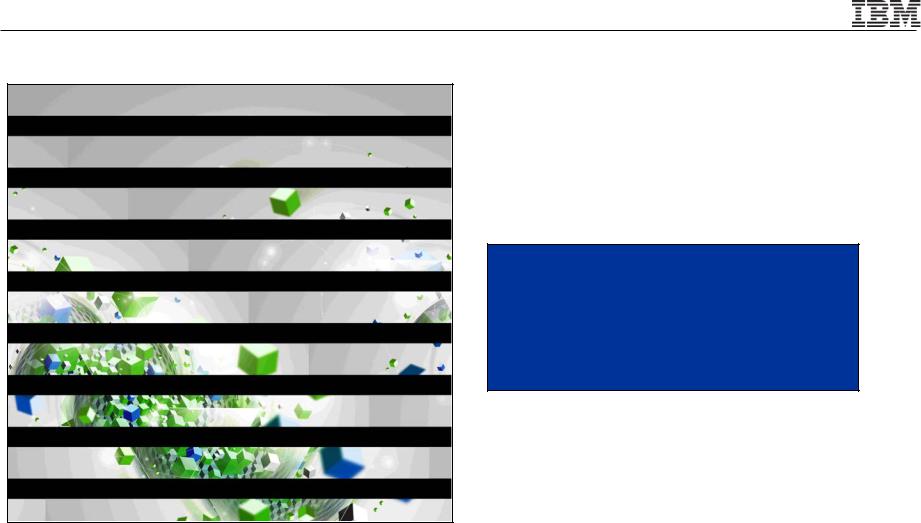
IBM Power Systems
POWER7
Pushing the
Limits
Power your planet
© 2010 IBM Corporation
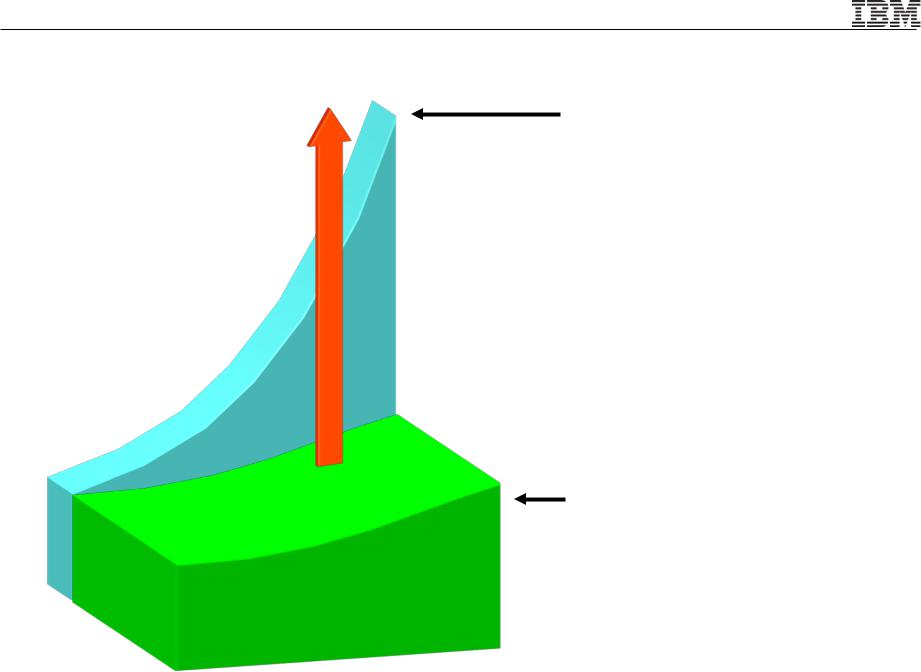
IBM Power Systems
Challenge: Beating Physics to Realize Multi-core Potential
Need to Amplify Effective |
Compute Throughput Potential |
Socket Throughput |
|
to Close Gap and |
|
Achieve Potential |
|
Socket Throughput Limitation
(Physical signal economics)
Power your

© 2010 IBM Corporation
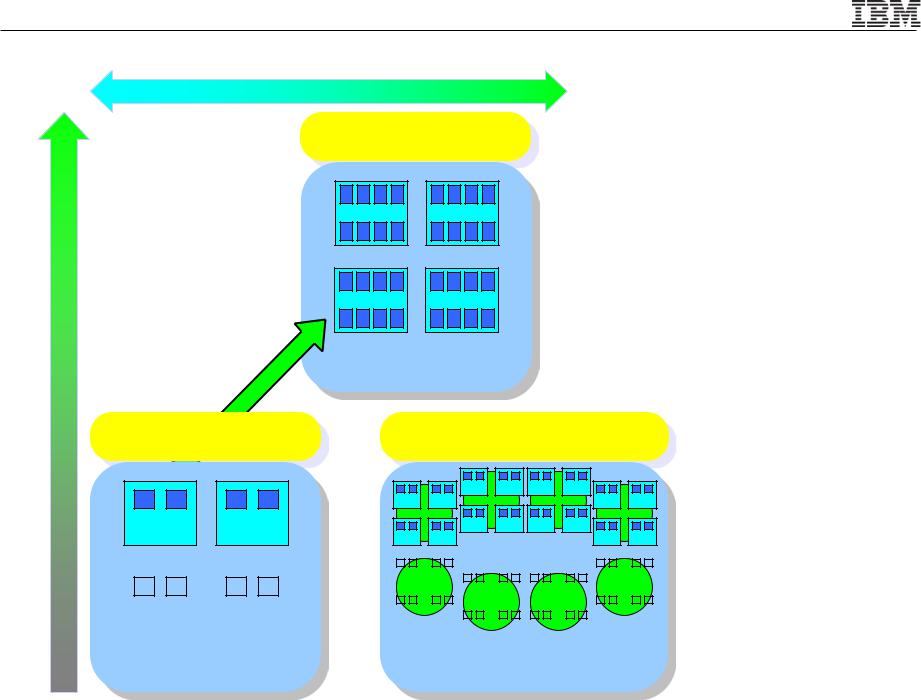
IBM Power Systems
Trends in Server Evolution
Time
Single Image
Enabled by:
-Technology
-Innovation
Driven by:
-IT Evolution
-Economics
Traditional Entry Server
Single Image Platform
Virtualized/Cloud
Emerging Entry Server
Virtualized/Cloud Platform
8-core 8-core
-A simple matter of riding the multi-core trend?
-Add more cores to the die, beef up some interfaces, and scale to a large SMP?
8-core 8-core
2 to 4 socket
16 to 32-way SMP Server
Traditional High-End Server
Virtualized Consolidation Platform
2-core 2-core
|
|
|
|
|
|
|
|
|
|
|
|
|
|
|
|
|
|
|
|
|
|
|
|
|
|
|
|
|
|
|
|
|
|
|
|
|
|
|
|
|
|
|
|
|
|
|
|
|
|
|
|
|
|
|
|
|
|
|
|
|
|
|
|
|
|
|
|
|
|
|
|
|
|
|
|
|
|
|
|
|
|
|
|
|
|
|
|
|
|
|
|
|
|
|
|
|
|
|
|
|
|
|
|
|
|
|
|
|
|
|
|
|
|
|
|
|
|
|
|
|
|
|
|
|
|
|
|
|
|
|
|
|
|
|
|
|
|
|
|
|
|
|
|
|
|
|
|
|
|
|
|
|
|
|
|
|
|
|
|
|
|
|
|
|
|
|
|
|
|
|
|
|
|
|
|
|
|
|
|
|
|
|
|
|
|
|
|
|
|
|
|
|
|
|
|
|
|
|
|
|
|
|
|
|
|
|
|
|
|
|
|
|
|
|
|
|
|
|
|
|
|
2-core |
|
|
2-core |
|
|
|
|
|
|
|
|
|
|
|
|
|
|
|
|
|
|
|
|
|
|
|
|
|
|
|
|
|
|
|
|
||||||
|
|
|
|
|
|
|
|
|
|
|
|
|
|
|
|
|
|
|
|
|
|
|
|
|
|
|
|
|
|
|
|||||||||||||
|
|
|
|
|
|
|
|
|
|
|
|
|
|
|
|
|
|
|
|
|
|
|
|
|
|
|
|
|
|
|
|
|
|
|
|
|
|
|
|
|
|||
|
|
|
|
|
|
|
|
|
|
|
|
|
|
|
|
|
|
|
|
|
|
|
|
|
|
|
|
|
|
|
|
|
|
|
|
|
|
|
|
|
|||
|
|
|
2 to 4 socket |
|
|
|
|
|
|
|
|
|
8 to 32 socket |
|
|
|
|
||||||||||||||||||||||||||
Power 4 to 8-way SMP Server |
|
|
|
|
16 to 64-way SMP Server |
|
|
|
|
||||||||||||||||||||||||||||||||||
*Statements regarding SMP servers
do not imply that IBM will introduce a system©with2010thisIBMcapabilityCorporation.

IBM Power Systems
Time
Trends in Server Evolution
Single Image
Enabled by:
-Technology
-Innovation
Driven by:
-IT Evolution
-Economics
Traditional Entry Server
Single Image Platform
2-core 2-core
2-core 2-core
2 to 4 socket
4 to 8-way SMP Server
Virtualized/Cloud
Emerging Entry Server
Virtualized/Cloud Platform
8-core 8-core
8-core
2 to 4
16 to 32-way
-A simple matter of riding the multi-core trend?
-Add more cores to the die, beef up some interfaces, and scale to a large SMP?
Not so simple:
-Emerging entry servers have characteristics similar to traditional high-end large SMP servers
Server
Platform
Achieving solid virtual machine performance requires a Balanced System Structure.
8 to 32 socket
16 to 64-way SMP Server * Statements regarding SMP servers do not imply that IBM will introduce
a system©with2010thisIBMcapabilityCorporation.

IBM Power Systems
Time
Trends in Server Evolution
Single Image
Enabled by:
-Technology
-Innovation
Driven by:
-IT Evolution
-Economics
Traditional Entry Server
Single Image Platform
2-core 2-core
2-core 2-core
2 to 4 socket
4 to 8-way SMP Server
Virtualized/Cloud |
UltraScale Cloud |
|
Emerging Entry Server |
Emerging High-End Server |
|
Virtualized/Cloud Platform |
UltraScale Cloud Platform |
|
8-core |
8-core |
|
|
|
|
|
|
|
|
|
|
|
|
|
|
|
|
|
|
|
|
|
|
|
|
|
|
|
|
|
|
|
|
|
|
|
|
|
|
|
|
|
|
|
|
|
|
|
|
|
|
|
|
|
|
|
|
|
|
|
|
|
|
|
|
|
|
|
|
|
|
|
|
|
|
|
|
|
|
|
|
|
|
|
|
|
|
|
|
|
|
|
|
|
|
|
|
|
|
|
|
|
|
|
|
|
|
|
|
|
|
|
|
|
|
|
|
|
|
|
|
|
|
|
|
|
|
|
|
|
|
|
|
|
|
|
|
|
|
|
|
|
|
|
|
|
|
|
|
|
|
|
|
|
|
|
|
|
|
|
|
|
|
|
|
|
|
|
|
|
|
|
|
|
|
|
|
|
|
|
|
|
|
|
|
|
|
|
|
|
|
|
|
|
|
|
|
|
|
|
|
|
|
|
|
|
|
|
|
|
|
|
|
|
|
|
|
|
|
|
|
|
|
|
|
|
|
|
|
|
|
|
|
|
|
|
|
|
|
|
|
|
|
|
|
|
|
|
|
|
|
|
|
|
|
|
|
|
|
|
|
|
|
|
|
|
|
|
|
|
|
|
|
|
|
|
|
|
|
|
|
|
|
|
|
|
|
|
|
|
|
|
|
|
|
|
|
|
|
|
|
|
|
|
|
|
|
|
|
|
|
|
|
|
|
|
|
|
|
|
|
|
|
|
|
|
|
|
|
|
|
|
|
|
|
|
|
|
|
|
|
|
|
|
|
|
|
|
|
|
|
|
|
|
|
|
|
|
|
|
|
|
|
|
|
|
|
|
|
|
|
|
|
|
|
|
|
|
|
|
|
|
|
|
|
|
|
|
|
|
|
|
|
|
|
|
|
|
|
|
|
|
|
|
|
|
|
|
|
|
|
|
|
|
|
|
|
|
|
|
|
|
|
|
|
|
|
|
|
|
|
|
|
|
|
|
|
|
|
|
|
|
|
|
|
|
|
|
|
|
|
|
|
|
|
|
|
|
|
|
|
|
|
|
|
|
|
|
|
|
|
|
|
|
|
|
|
|
|
|
|
|
|
|
|
|
|
|
|
|
|
|
|
|
|
|
|
|
|
|
|
|
|
|
|
|
|
|
|
|
|
|
|
|
|
|
|
|
|
|
|
|
|
|
|
|
|
|
|
|
|
|
|
|
|
|
|
|
|
|
|
|
|
|
|
|
|
|
|
|
|
|
|
|
|
|
|
|
|
|
|
|
|
|
|
|
|
|
|
|
|
|
|
|
|
|
|
|
|
|
|
|
|
|
|
|
|
|
|
|
|
|
|
|
|
|
|
|
|
|
|
|
|
|
|
|
|
|
|
|
|
|
|
|
|
|
|
|
|
|
|
|
|
|
|
|
|
|
|
|
|
|
|
|
|
|
|
|
|
|
|
|
|
|
8-core |
|
|
8-core |
|
|
|
|
|
|
|
|
|
|
|
|
|
|
|
|
|
|
|
|
|
|
|
|
|
|
|
|
|
|
|
|
|
|
|
|
|
|
|
|
|
|
|
|
|
|
|
|
|
|
|
|
|
|
|
|
|
|
|
|
|
|
||||||||||||
|
|
|
|
|
|
|
|
|
|
|
|
|
|
|
|
|
|
|
|
|
|
|
|
|
|
|
|
|
|
|
|
|
|
|
|
|
|
|
|
|
|
|
|
|
|
|
|
|
|
|
|
|
|
|
|
|
|
|
|
|
|
|
|
|
|
||||||||||||||
|
|
|
|
|
|
|
|
|
|
|
|
|
|
|
|
|
|
|
|
|
|
|
|
|
|
|
|
|
|
|
|
|
|
|
|
|
|
|
|
|
|
|
|
|
|
|
|
|
|
|
|
|
|
|
|
|
|
|
|
|
|
|
|
|
|
|
|
|
|
|
|
|
|
|
|
|
|
|
|
|
|
|
|
|
|
|
|
|
|
|
|
|
|
|
|
|
|
|
|
|
|
|
|
|
|
|
|
|
|
|
|
|
|
|
|
|
|
|
|
|
|
|
|
|
|
|
|
|
|
|
|
|
|
|
|
|
|
|
|
|
|
|
|
|
|
|
|
|
|
|
|
|
|
|
|
|
|
|
|
|
|
|
|
|
|
|
|
|
|
|
|
|
|
|
|
|
|
|
|
|
|
|
|
|
|
|
|
|
|
|
|
|
|
|
|
|
|
|
|
|
|
|
|
|
|
|
|||||||||||||||||||||||||||||||||
|
|
|
|
|
2 to 4 socket |
|
|
|
|
|
|
|
|
|
|
|
|
|
8 to 32 socket |
||||||||||||||||||||||||||||||||||||||||||||||||||||||||||||
16 to 32-way SMP Server |
|
64 to 256-way SMP Server |
|||||||||||||||||||||||||||||||||||||||||||||||||||||||||||||||||||||||||||||
|
|
|
|
|
|
|
|
|
|
Traditional High-End Server |
|
|
|
|
|
|
|
|
|
|
|
|
|
|
|
|
|
Same enablers and |
|||||||||||||||||||||||||||||||||||||||||||||||||||
|
|
|
|
|
|
|
|
|
Virtualized Consolidation Platform |
|
|
|
|
|
|
|
|
|
driving factors apply |
||||||||||||||||||||||||||||||||||||||||||||||||||||||||||||
at larger scale
8 to 32 socket
16 to 64-way SMP Server * Statements regarding SMP servers do not imply that IBM will introduce
a system©with2010thisIBMcapabilityCorporation.
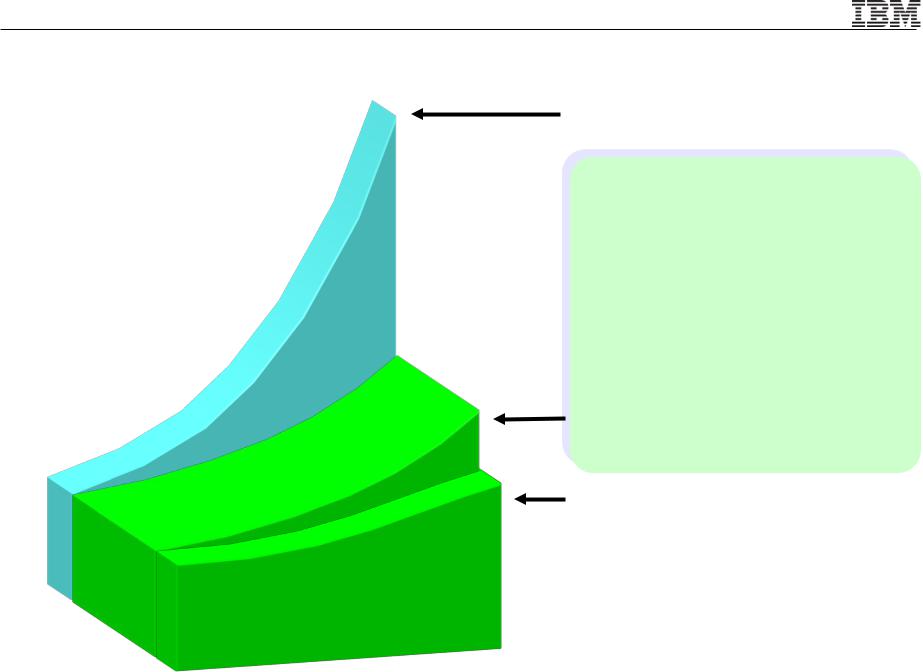
IBM Power Systems
Challenge: How does POWER7 maintain the Balance?
Need to Amplify Effective Socket Throughput to Close Gap and Achieve Potential
Compute Throughput Potential
Cache Hierarchy Technology
and Innovation
Socket Throughput Limitation
(Physical signal economics)
Power your 


© 2010 IBM Corporation
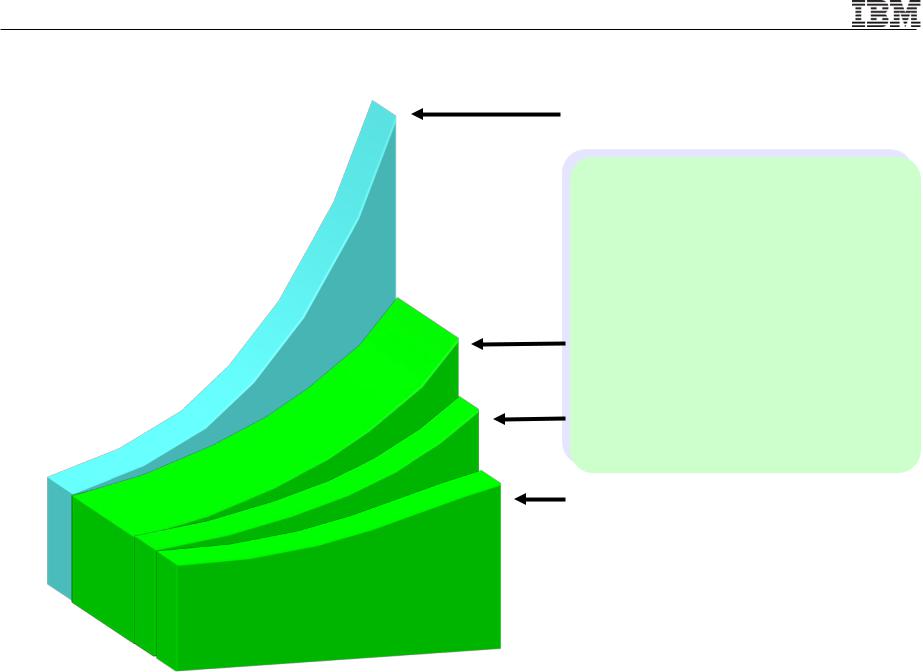
IBM Power Systems
Challenge: How does POWER7 maintain the Balance?
Need to Amplify Effective Socket Throughput to Close Gap and Achieve Potential
Compute Throughput Potential
Advances in Memory Subsystem
Cache Hierarchy Technology
and Innovation
Socket Throughput Limitation
(Physical signal economics)
Power your 


© 2010 IBM Corporation
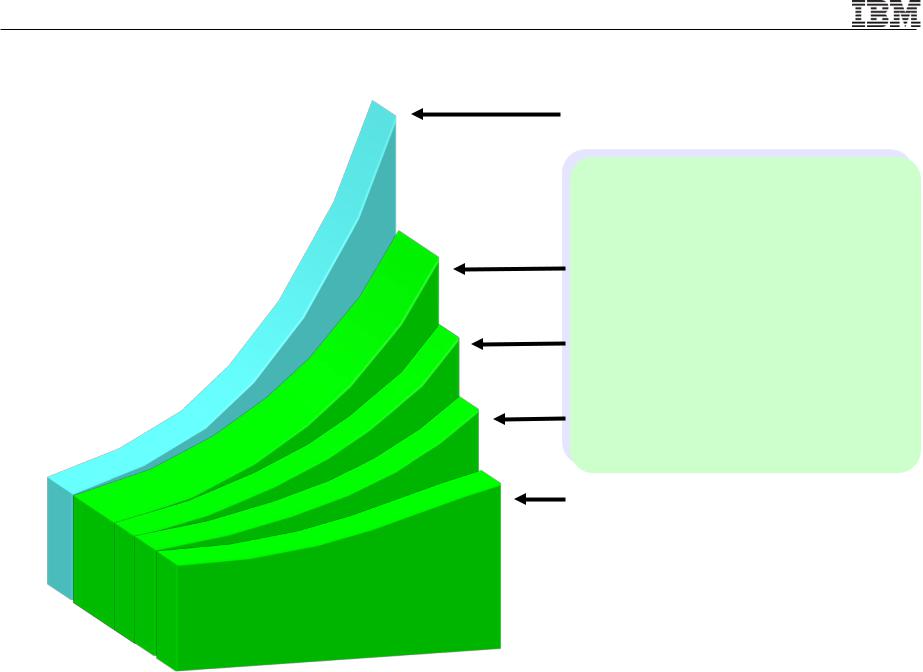
IBM Power Systems
Challenge: How does POWER7 maintain the Balance?
Need to Amplify Effective Socket Throughput to Close Gap and Achieve Potential
Compute Throughput Potential
Advances in Off-Chip Signaling
Technology
Advances in Memory Subsystem
Cache Hierarchy Technology
and Innovation
Socket Throughput Limitation
(Physical signal economics)
Power your 


© 2010 IBM Corporation
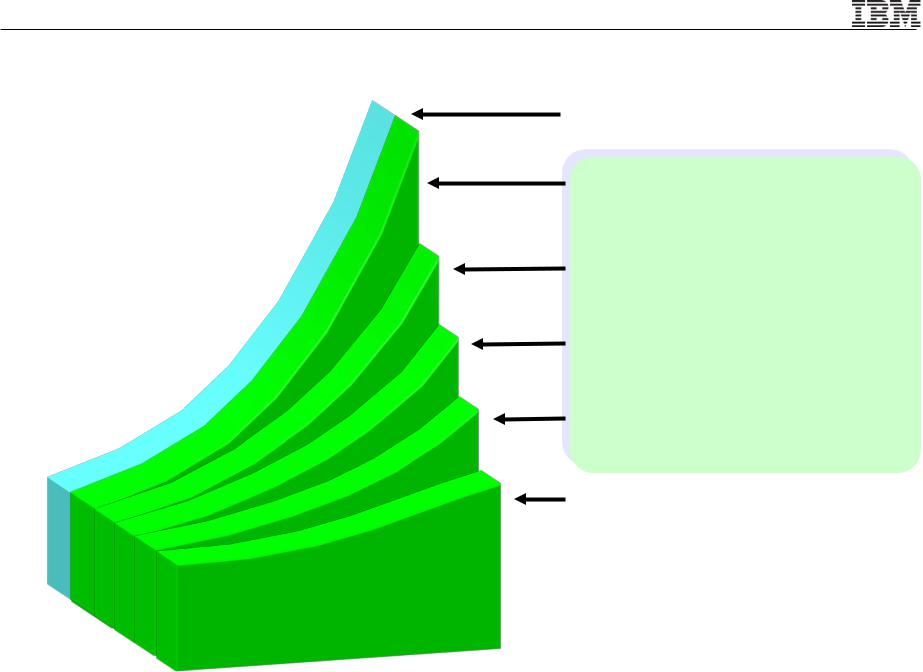
IBM Power Systems
Challenge: How does POWER7 maintain the Balance?
Need to Amplify Effective Socket Throughput to Close Gap and Achieve Potential
Compute Throughput Potential
Exploit Long Term Investment
in Coherence Innovation
Advances in Off-Chip Signaling
Technology
Advances in Memory Subsystem
Cache Hierarchy Technology
and Innovation
Socket Throughput Limitation
(Physical signal economics)
Power your 


© 2010 IBM Corporation
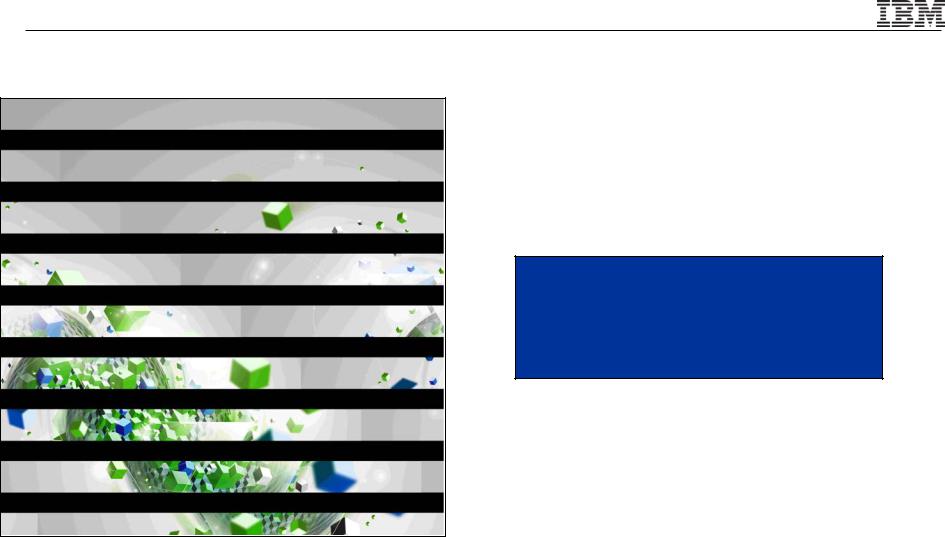
IBM Power Systems
POWER7
Processor
Power your planet
© 2010 IBM Corporation
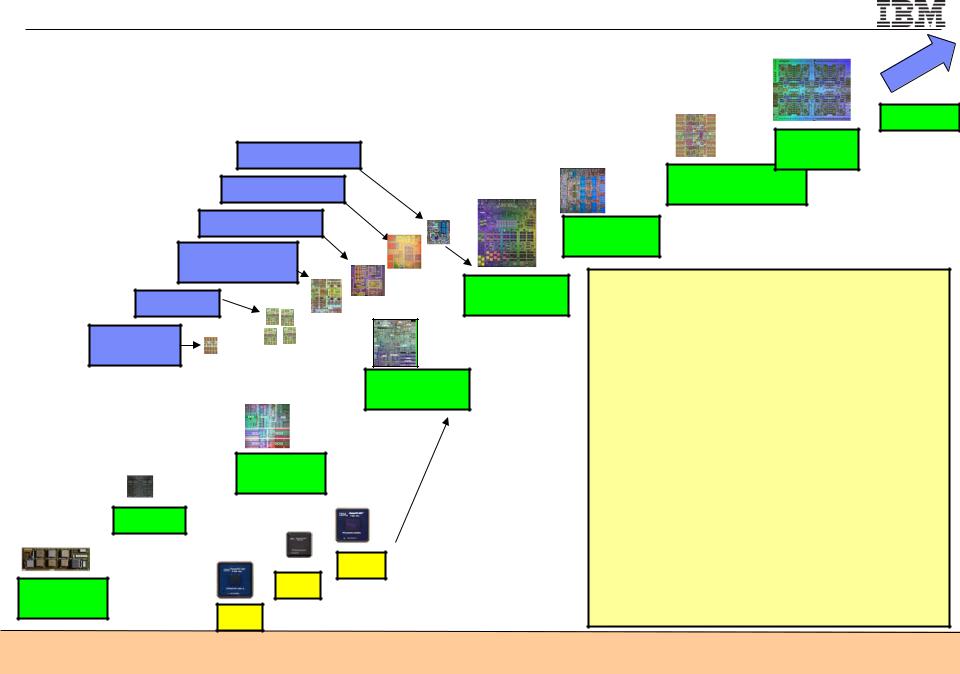
IBM Power Systems |
|
|
|
|
|
|
20+ Years of POWER Processors |
45nm |
|||||
|
||||||
|
|
|
|
|
65nm |
Next Gen. |
|
|
|
|
|
|
|
|
|
RS64IV Sstar |
|
130nm |
POWER7 |
|
|
|
|
-Multi-core |
|||
|
|
RS64III Pulsar |
|
180nm |
POWER6TM |
|
|
|
|
-Ultra High Frequency |
|||
|
|
RS64II North Star |
.18um |
|
|
|
|
|
.25um |
|
POWER5TM |
|
|
|
RS64I Apache |
.35um |
|
-SMT |
|
|
|
|
|
|
|||
|
BiCMOS |
.5um |
|
Major POWER® Innovation |
||
|
|
.5um |
|
POWER4TM |
||
Muskie A35 |
.22um |
-Dual Core |
-1990 RISC Architecture |
|
||
|
|
|||||
-Cobra A10 |
.5um |
|
|
-1994 SMP |
|
|
|
|
-1995 Out of Order Execution |
||||
|
|
|
|
|||
-64 bit |
|
|
|
|
-1996 64 Bit Enterprise Architecture |
|
|
|
|
|
|
||
|
|
.35um |
POWER3TM |
|
-1997 Hardware Multi-Threading |
|
|
|
-630 |
|
-2001 Dual Core Processors |
||
|
|
|
|
|
-2001 Large System Scaling |
|
|
|
|
|
|
-2001 Shared Caches |
|
.72um |
|
POWER2TM |
|
-2003 On Chip Memory Control |
||
|
|
P2SC |
|
|
-2003 SMT |
|
|
|
|
.25um |
|
-2006 Ultra High Frequency |
|
RSC |
|
.35um |
|
-2006 Dual Scope Coherence Mgmt |
||
|
|
-2006 Decimal Float/VSX |
|
|||
1.0um |
|
.6um |
|
|
|
|
|
|
|
|
-2006 Processor Recovery/Sparing |
||
|
|
|
604e |
|
||
|
|
|
|
-2009 Balanced Multi-core Processor |
||
|
|
-603 |
|
|
||
POWER1 |
|
|
|
-2009 On Chip EDRAM |
|
|
|
|
|
|
|
||
-AMERICA’s |
|
-601 |
|
|
|
|
|
|
|
|
|
|
|
1990 |
1995 |
2000 |
2005 |
2010 |
Power your planet
* Dates represent approximate processor power-on©dates,2010notIBMsystemCorporationavailability
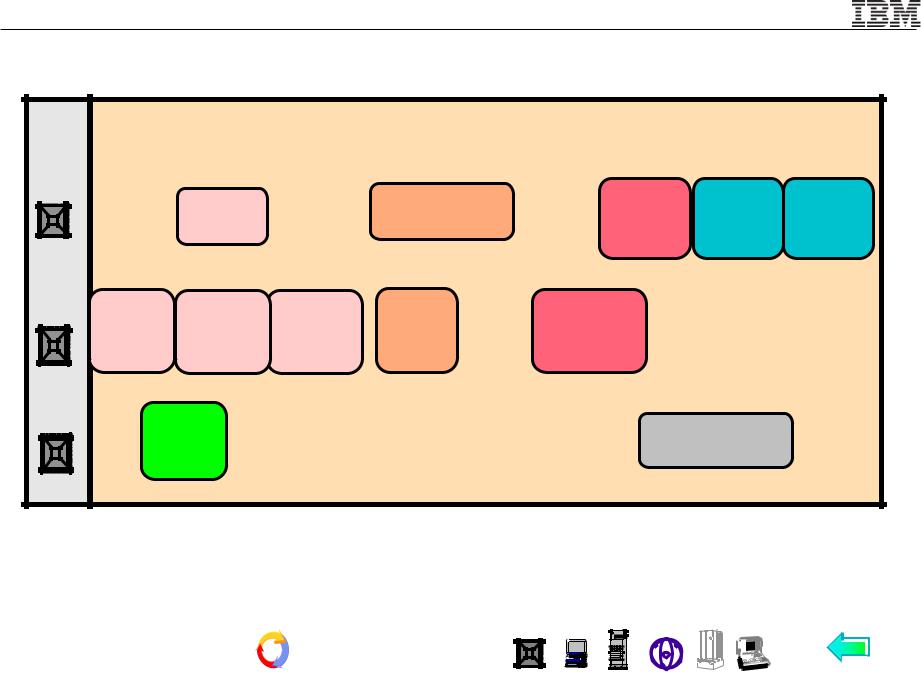
IBM Power Systems
IBM risc processors have many innovations..
|
|
|
pSeries p640, |
|
|
|
|
64bit |
|
|
|
p610 |
|
|
|
P2,P3,P4 |
|
Power3 |
|
Power3-II |
POWER4 |
POWER4 |
POWER4 |
|
|
|
|||||
|
|
200+ |
|
333 / 375 / 450 |
1.1+GHz |
1.5GHz |
1.8GHz |
64bit |
RS64 |
RS64-II |
RS64-II |
RS64-III |
RS64-IV |
Regatta |
|
|
|
||||||
|
Apache |
Northstar |
Northstar |
Pulsar |
Sstar |
|
|
|
125 |
262.5 |
340 |
450 |
600+ / 750 |
|
|
32bit |
|
|
|
pSeries p620, p660, & p680 |
|
||
|
604e |
|
|
|
7450 |
|
|
|
|
|
|
|
|
||
|
332 / 375 |
|
|
800MHz/1.0GHz |
|
||
|
|
1998 |
1999 |
2000 |
2001 |
2002 |
2003 |
Copper =
 & SOI =
& SOI =
 & low-k =
& low-k = 
Power your planet |
Σ |
© 2010 IBM Corporation |

IBM Power Systems
Processor Technology Roadmap
POWER5
130 nm
POWER4
180 nm
Dual Core
Chip Multi Processing
Distributed Switch
Shared L2
Dynamic LPARs (32)
Dual Core
Enhanced Scaling
SMT
Distributed Switch +
Core Parallelism +
FP Performance +
Memory bandwidth +
Virtualization
|
|
|
|
|
|
|
|
|
|
|
|
|
|
|
|
|
|
|
|
|
POWER8 |
||
|
|
POWER7 |
|
|
|
|
|
|
|
|
|
||||
|
|
45 nm |
|
||||
POWER6 |
|||||||
|
|
|
|
|
|
||
65 nm |
|
|
|
|
|
|
|
Dual Core
High Frequencies
Virtualization +
Memory Subsystem +
Altivec
Instruction Retry
Dyn Energy Mgmt
SMT +
Protection Keys
Multi Core
On-Chip eDRAM
Power Optimized Cores
Mem Subsystem ++ |
Concept Phase |
|
SMT++ |
||
|
||
Reliability + |
|
|
VSM & VSX (AltiVec) |
|
|
Protection Keys+ |
|
2001 |
2004 |
2007 |
2010 |
Power your planet
© 2010 IBM Corporation
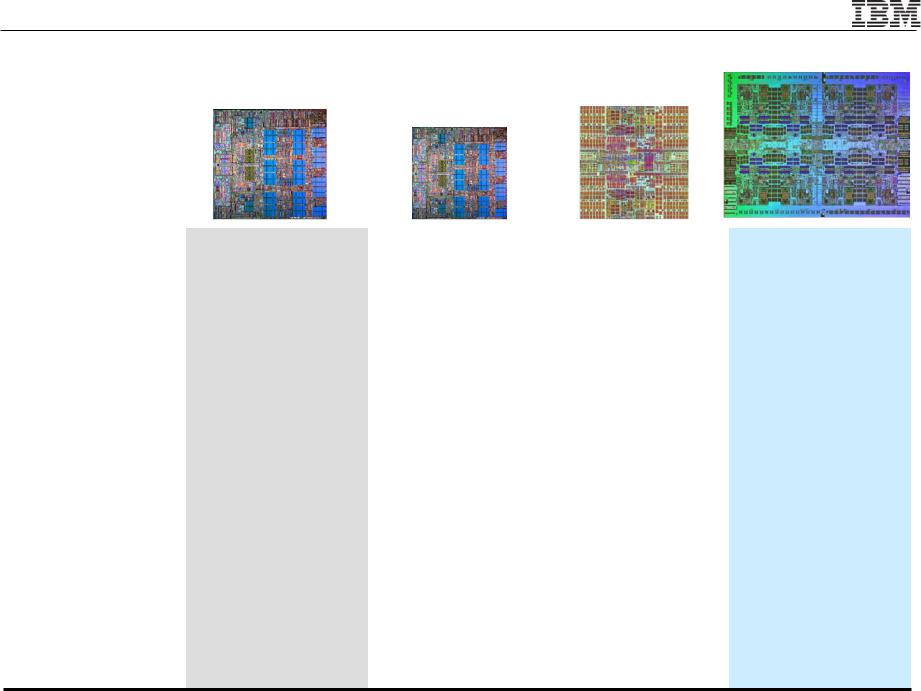
IBM Power Systems
Processor Designs
contrast: 0.278nm H2O
|
|
|
POWER5 |
POWER5+ |
POWER6 |
POWER7 |
|
|
|
|
|
|
|
|
|
|
Technology |
|
130 nm |
90 nm |
60 nm |
45 nm |
|
|
|
|
|
|
|
|
|
|
Size |
|
389 mm2 |
245 mm2 |
341 mm2 |
567 mm2 |
|
|
Transistors |
|
276 M |
276 M |
790 M |
1.2 B |
|
|
|
|
|
|
|
|
|
|
Cores |
|
2 |
2 |
2 |
4 / 6 / 8 |
|
|
|
|
|
|
|
|
|
|
Frequencies |
|
1.65 GHz |
1.9 GHz |
3-5 GHz |
3-4 GHz |
|
|
|
|
|
|
|
|
|
|
L2 Cache |
|
1.9 MB Shared |
1.9 MB Shared |
4 MB / Core |
256 KB / Core |
|
|
|
|
|
|
|
|
|
|
L3 Cache |
|
36 MB |
36 MB |
32 MB |
4 MB / Core |
|
|
|
|
|
|
|
|
|
|
Memory Cntrl |
|
1 |
1 |
2 / 1 |
2 |
|
|
|
|
|
|
|
|
|
|
LPAR |
|
10 / Core |
10 / Core |
10 / Core |
10 / Core |
|
|
Power your |
|
planet |
|
|
© 2010 IBM Corporation |
|
|
|
|
|
|
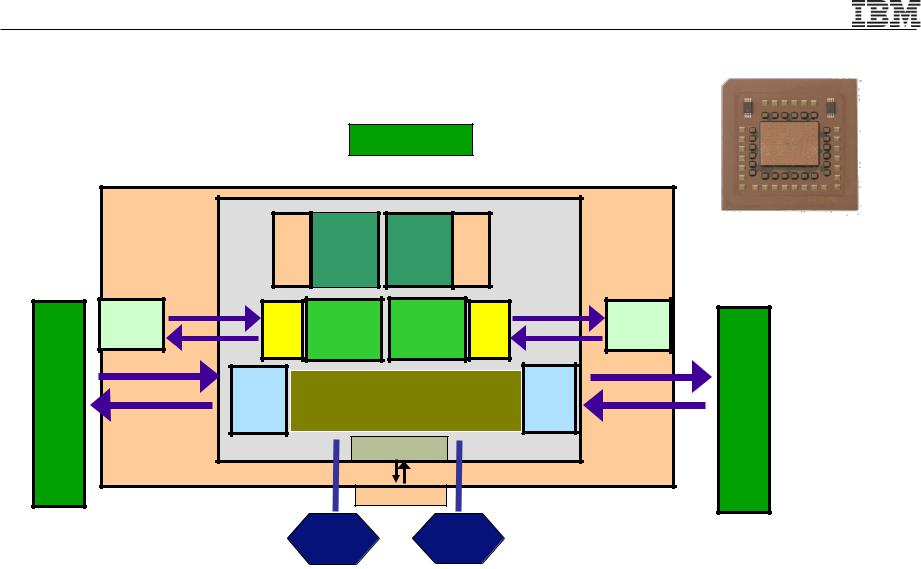
IBM Power Systems
POWER6 / POWER7
M E M O R Y
POWER6
|
Alti |
SMT |
SMT |
Alti |
|
|
|
|
Vec |
Core |
Core |
Vec |
|
|
|
L3 |
L3 |
4MB |
4MB |
L3 |
|
L3 |
M |
|
L2 |
L2 |
|
|
|||
|
Dir |
Dir |
|
|
E |
||
|
|
|
|
|
Mem |
|
|
|
Mem |
Bus Fabric Controller |
|
M |
|||
|
Ctrl |
Ctrl |
|
||||
|
|
|
|
|
O |
||
|
|
GX Bus Cntrl |
|
|
|
||
|
|
|
|
|
R |
||
|
|
|
|
|
|
|
|
|
|
GX+ Bridge |
|
|
|
Y |
|
|
|
Chip |
Chip |
|
|
|
|
|
|
to Chip |
to Chip |
|
|
|
|
Power your planet
© 2010 IBM Corporation

IBM Power Systems
POWER6 / POWER7
 POWER67
POWER67 
M E M O R Y
Alti |
SMT |
SMT |
Alti |
Vec |
Core |
Core |
Vec |
|
L3 Cache |
|
|
|
|
|
L3 |
4MB |
4MB |
L3 |
|
L3 |
M |
Dir |
L2 |
L2 |
|
|
||
Dir |
|
|
E |
|||
|
|
|
|
Mem |
|
|
Mem |
Bus Fabric Controller |
|
M |
|||
Ctrl |
Ctrl |
|
||||
|
|
|
|
O |
||
|
GX Bus Cntrl |
|
|
|
||
|
|
|
|
R |
||
|
|
|
|
|
|
|
|
GX+ Bridge |
|
|
|
Y |
|
|
Chip |
Chip |
|
|
|
|
|
to Chip |
to Chip |
|
|
|
|
eDRAM (Embedded Dynamic RAM)
|
L3 — 6:1 latency improvement (vs. external L3) and 2x BW improvements |
|
|
|
Capacitor vs transister |
|
1/3 space (vs 6Trn SRAM cell), 1/5 standby power of standard SRAM |
|
|
Soft error rated 250x lower than SRAM |
|
Power your planet |
Savings of ~ 1.5B transistors over other RAM |
|
|
© 2010 IBM Corporation |
|
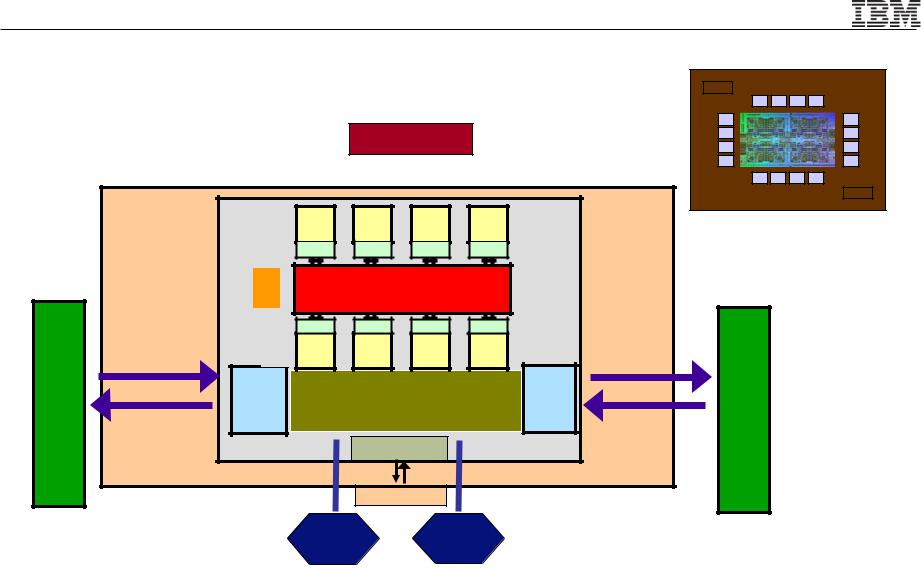
IBM Power Systems
POWER6 / POWER7
POWER7
P |
SMT |
SMT |
SMT |
SMT |
||
WO |
Core |
Core |
Core |
Core |
||
Alti |
L2 |
SMT |
L2 |
SMT |
Alti |
|
E |
|
Core |
L2 |
L2 |
||
R Vec |
|
|
Core |
Vec |
||
|
G |
|
L3 Cache |
|
|
|
|||
|
X |
|
|
|
|
||||
M |
BL3 |
4MB |
L2 |
4MB |
L3 |
|
M |
||
U |
L2 |
|
L2 |
L2 |
|
||||
E |
Dir |
SMT |
L2 SMT |
L2 |
Dir |
|
|
||
S |
|
|
|
SMT |
SMT |
|
E |
||
|
Core |
Core |
Core |
Core |
|
||||
M |
Mem |
Bus Fabric Controller |
Mem |
M |
|||||
Ctrl |
Ctrl |
||||||||
O |
|
|
|
|
|
O |
|||
|
|
GX Bus Cntrl |
|
|
|||||
R |
|
|
|
|
R |
||||
|
|
|
|
|
|
|
|||
Y |
|
|
GX+ Bridge |
|
|
Y |
|||
|
|
Chip |
|
Chip |
|
|
|
||
|
|
to Chip |
|
to Chip |
|
|
|||
|
Footprints of working set: |
|
|
|
|||||
|
Private footprints automatically migrates to fast local region 4m/core |
||||||||
|
Shared data automatically cloned to multiple private regions |
|
|||||||
Power your planet
© 2010 IBM Corporation
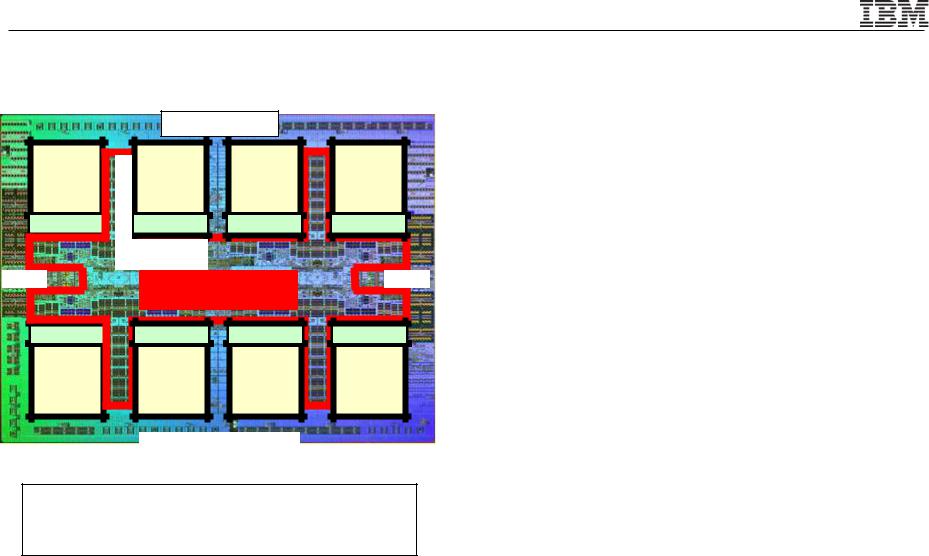
IBM Power Systems
POWER7 Processor Chip Cores : 8 ( 4 / 6 core options )
Local SMP Links
POWER7 |
CORE |
L2 Cache |
MC0
L2 Cache |
POWER7 |
CORE |
F |
POWER7 |
|
CORE |
||
A |
||
S |
|
|
T |
L2 Cache |
POWER7 |
CORE |
L2 Cache |
L3 REGION
L3 Cache and
Chip Interconnect
L2 Cache |
POWER7 |
CORE |
L2 Cache |
POWER7 |
CORE |
POWER7 |
CORE |
L2 Cache |
MC1
L2 Cache |
POWER7 |
CORE |
Remote SMP & I/O Links
567mm2 Technology:
45nm li’thography, Cu, SOI, eDRAM
Transistors: 1.2 B
Equivalent function of 2.7B
eDRAM efficiency
Eight processor cores
12 execution units per core
4 Way SMT per core – up to 4 threads per core
32 Threads per chip
L1: 32 KB I Cache / 32 KB D Cache
L2: 256 KB per core
L3: Shared 32MB on chip eDRAM
Dual DDR3 Memory Controllers
90 GB/s Memory bandwidth per chip
Binary Compatibility with POWER6
Scalability up to 32 Sockets
360 GB/s SMP bandwidth/chip
20,000 coherent operations in flight
Power your planet
4th Generation SMP Fabric Bus
3rd Generation Multi-Threading
Energy Optimized Design
Enhanced GX System Buses
DDR3 memory
On-chip eDRAM L3
© 2010 IBM Corporation
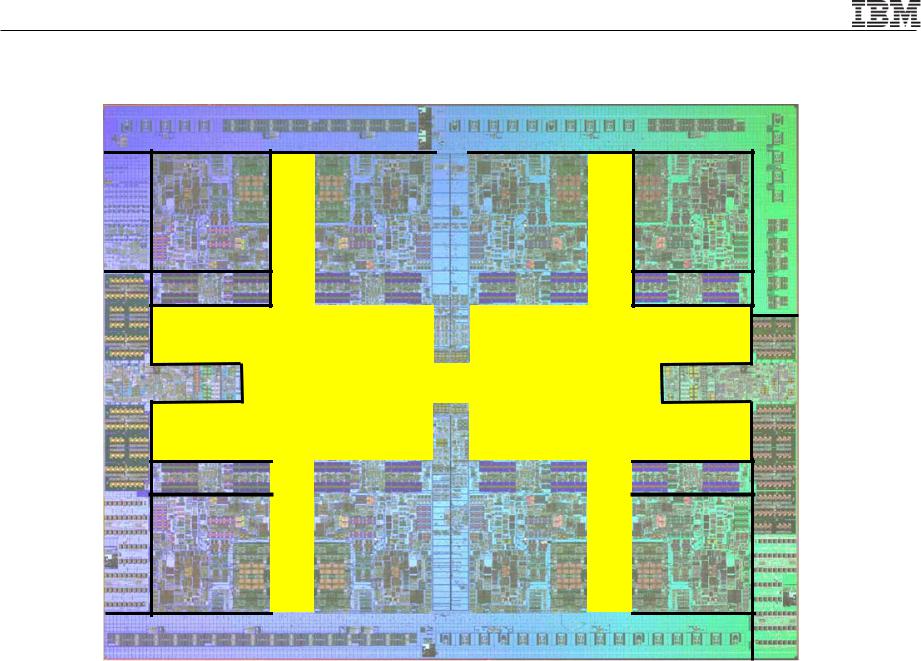
IBM Power Systems
Cache Hierarchy Technology and Innovation
Core
L2 Cache
Mem Ctrl
L2 Cache
Core
Power your planet
Core |
Local |
Core |
|
SMP |
|
L2 Cache |
Links |
L2 Cache |
|
|
|
|
|
|
|
|
|
L3 Cache and Chip Interconnect
|
|
Remote |
|
|
|
L2 Cache |
L2 Cache |
|
|
|
+ SMP |
|
||
|
|
|
|
|
|
Core |
Core |
|
|
|
Links I/O |
|
||
|
|
|
|
|
|
|
|
|
Core
L2 Cache
Mem Ctrl
L2 Cache
Core
© 2010 IBM Corporation
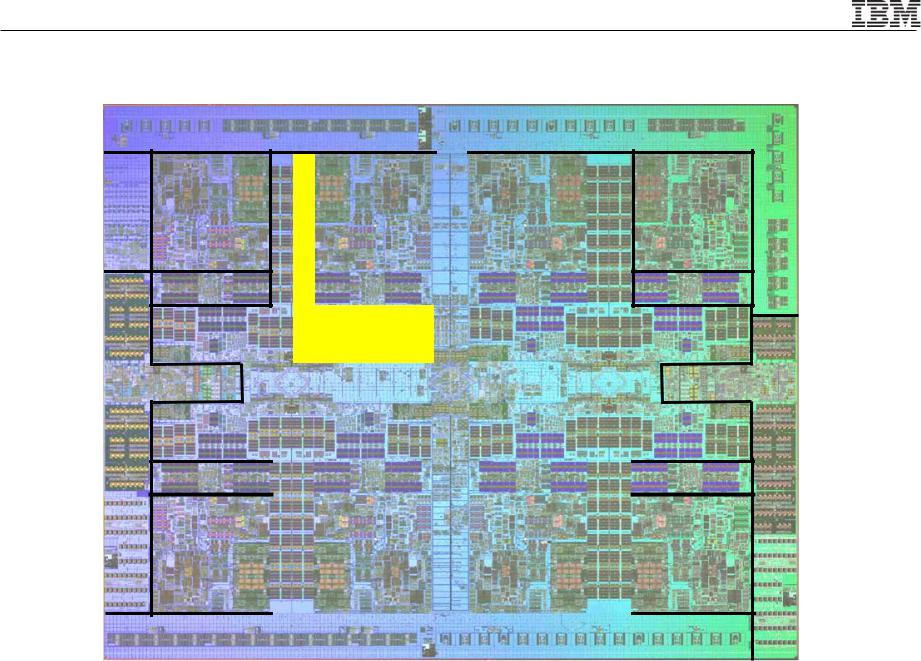
IBM Power Systems
Cache Hierarchy Technology and Innovation
Core
L2 Cache
Mem Ctrl
L2 Cache
Core
Power your planet
Core |
Local |
Core |
|
SMP |
|
L2 Cache |
Links |
L2 Cache |
|
|
|
Fast Local |
|
|
|
|
|
L3 Region |
|
|
|
|
|
L3 Cache and Chip Interconnect
|
|
Remote |
|
|
|
L2 Cache |
L2 Cache |
|
|
|
+ SMP |
|
||
|
|
|
|
|
|
Core |
Core |
|
|
|
Links I/O |
|
||
|
|
|
|
|
|
|
|
|
Core
L2 Cache
Mem Ctrl
L2 Cache
Core
© 2010 IBM Corporation
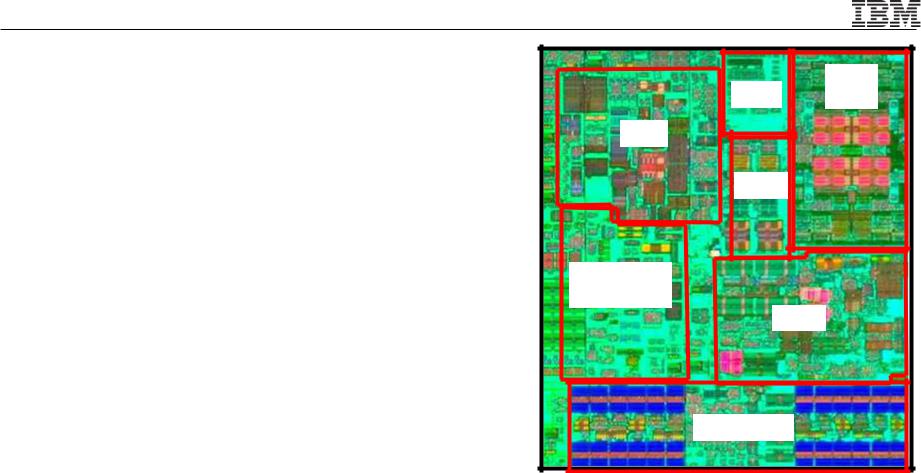
IBM Power Systems
POWER7 Core
64-bit PowerPC architecture v2.07 Execution Units
•2 Fixed Point Units
•2 Load Store Units
•4 Double Precision Floating Point Units
•1 Branch
•1 Condition Register
•1 Vector Unit
•1 Decimal Floating Point Unit
•6 Wide Dispatch
•Units include distributed Recovery Function
Out of Order Execution excellent for commercial load
Modes: POWER6, POWER6+ and POWER7
e.g. partition mobility+
DFU |
VSX |
FPU |
|
ISU |
|
FXU |
|
IFU |
|
CRU/BRU |
|
LSU |
|
L2 Cache |
|
POWER7 continues to support VMX / Extends SIMD support with VSX
2 VSX (Vec Scalar Ext) units that can each handle 2 Double-Precision FP instructions
8 FLOPS per cycles
VSX units can also handle 4 Single Precision instructions per cycle
VSX instruction set support for vector and scalar instructions
Power your planet
© 2010 IBM Corporation
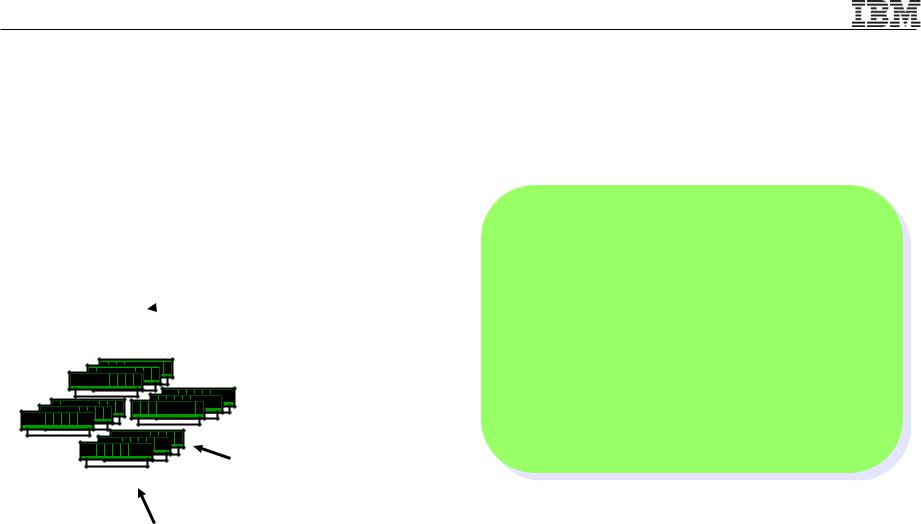
IBM Power Systems
Advances in Memory Subsystem
Memory Subsystem Requirement
for POWER Servers
Core
Need 10 to 20 GB/s  Sustained bandwidth
Sustained bandwidth
per Core
Need 16 to 32 GB of Storage per Core
Challenge
for Multi-core POWER7
Socket Challenge:
4x growth in memory bandwidth and capacity needed per socket.
System Challenge:
Packaging more memory into similar volume with
similar energy and cooling constraints.
Energy Constraints
Power your planet
© 2010 IBM Corporation
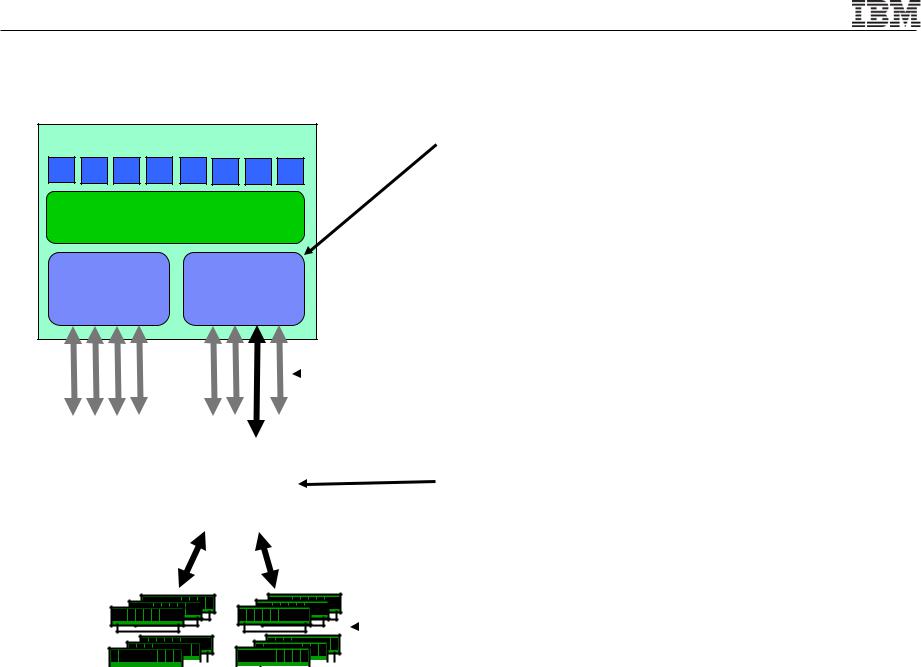
IBM Power Systems
Advances in Memory Subsystem
Multi-faceted Solution
POWER7 Chip |
1) Dual Integrated DDR3 Controllers |
||
|
|
- Massive 16KB scheduling window |
|
|
|
per POWER7 chip insures high |
|
|
|
channel and DIMM utilization |
|
|
|
- Sparse access acceleration |
|
Memory |
Memory |
- Advanced Energy Management |
|
- Numerous RAS advances |
|||
Controller |
Controller |
||
|
|||
 2) Eight high speed 6.4 GHz channels
2) Eight high speed 6.4 GHz channels
- New low power differential signaling - Sustained 100+ GB/s per socket
Advanced |
3) New DDR3 buffer chip architecture |
Buffer |
|
Chip |
- Larger capacity support (32 GB / core) |
|
- Energy Management support |
|
|
|
- RAS enablementh |
 4) DDR3 DRAMs
4) DDR3 DRAMs
- Supports 800, 1066, 1333, and 1600
|
|
|
|
|
|
|
|
|
|
|
|
|
|
|
|
|
|
Power |
|
your |
|
planet |
|
|
|
|
|
|
|
© 2010 IBM Corporation |
|||||
|
|
|
|
|
|
|
|
|
|
|
|
|
|
|
* Statements regarding memory subsystem features do not imply that IBM will introduce a system with these capabilities. |
||
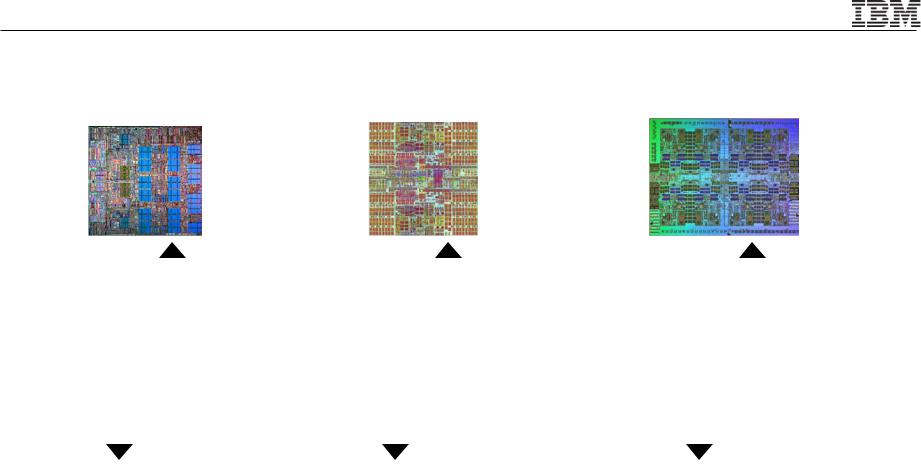
IBM Power Systems
Memory Channel Bandwidth Evolution
POWER5 |
POWER6 |
POWER7 |
|
|
|
|
|
|
|
|
|
|
|
|
|
|
|
|
|
|
|
|
|
|
|
|
|
|
|
|
|
|
|
|
|
|
Memory Performance: |
|
Memory Performance: |
|
Memory Performance: |
||||||||||||
2x DIMM |
|
4x DIMM |
|
6x DIMM |
||||||||||||
|
|
|
|
|
|
|
|
|
|
|
|
|
|
|
|
|
|
|
|
|
|
|
|
|
|
|
|
|
|
|
|
|
|
|
|
|
|
|
|
|
|
|
|
|
|
|
|
|
|
|
|
|
|
|
|
|
|
|
|
|
|
|
|
|
|
|
|
|
|
|
|
|
|
|
|
|
|
|
|
|
|
|
|
|
|
|
|
|
|
|
|
|
|
|
|
|
|
|
|
|
|
|
|
|
|
|
|
|
|
|
|
|
|
|
|
|
|
|
|
|
|
|
|
|
|
|
|
|
|
D |
|
|
D |
|
D |
|
D |
|
D |
|
D |
|
D |
|
D |
|
D |
|
D |
|
|
|
|
|
|
|
|
|
|
|
|
|
|
|
|
|
|
|
|
|
|
|
|
|
|
|
|
|
|
|
|
|
|
|
|
|
|
D |
|
|
D |
|
D |
|
D |
|
D |
|
D |
|
D |
|
D |
|
D |
|
D |
|
|
|
|
|
|
|
|
|
|
|
|
|
|
|
|
|
|
|
|
|
|
|
|
|
|
|
|
|
|
||||||||||||||||||||||||||||
|
|
|
|
|
|
|
|
|
|
|
|
|
|
|
|
|
|
|
|
|
|
|
|
|
|
|
|
|
|
|
|
|
|
|
|
|
|
R |
|
|
R |
|
R |
|
R |
|
R |
|
R |
|
R |
|
R |
|
R |
|
R |
|
|
|
|
|
|
|
|
|
|
|
|
|
|
|
|
|
|
|
|
|
|
|
|
|
|
|
|
|
|
||||||||||||||||||||||||||||
|
|
|
|
|
|
|
|
|
|
|
|
|
|
|
|
|
|
|
|
|
|
|
|
|
|
|
|
|
|
|
|
|
|
|
|
|
|
3 |
|
3 |
3 |
3 |
3 |
|
3 |
3 |
3 |
3 |
3 |
||||||||
|
|
|
|
|
|
|
|
|
|
|
|
|
|
|
|
|
|
|
|
|
|
|
|
|
|
|
|
|
|
|
|
|
|
|
|
|
|
|
|
|
|
|
|
|
|
|
|
|
|
|
|
|
|
|
|
|
|
|
|
|
|
|
|
|
|
|
|
|
|
|
|
|
|
|
|
|
|
|
|
|
|
|
|
|
|
|
|
|
|
|
|
|
|
|
|
|
|
|
|
|
|
|
|
|
|
|
|
|
|
|
|
|
|
|
|
|
|
|
DDR2 @ 553 MHz |
|
DDR2 @ 553 / 667 MHz |
|
DDR3 @ 1066 MHz |
|
|
||||||||||||||||||||||||||||||||||||||||||||||||
|
|
Effective Bandwidth: |
|
|
Effective Bandwidth: |
Effective Bandwidth: |
|
|
|||||||||||||||||||||||||||||||||||||||||||||||||
|
|
|
|
|
1.1 GB/s |
|
|
|
|
|
2.6 GB/sec |
|
|
|
|
|
6.4 GB/sec |
|
|
|
|
||||||||||||||||||||||||||||||||||||
Power your planet
© 2010 IBM Corporation
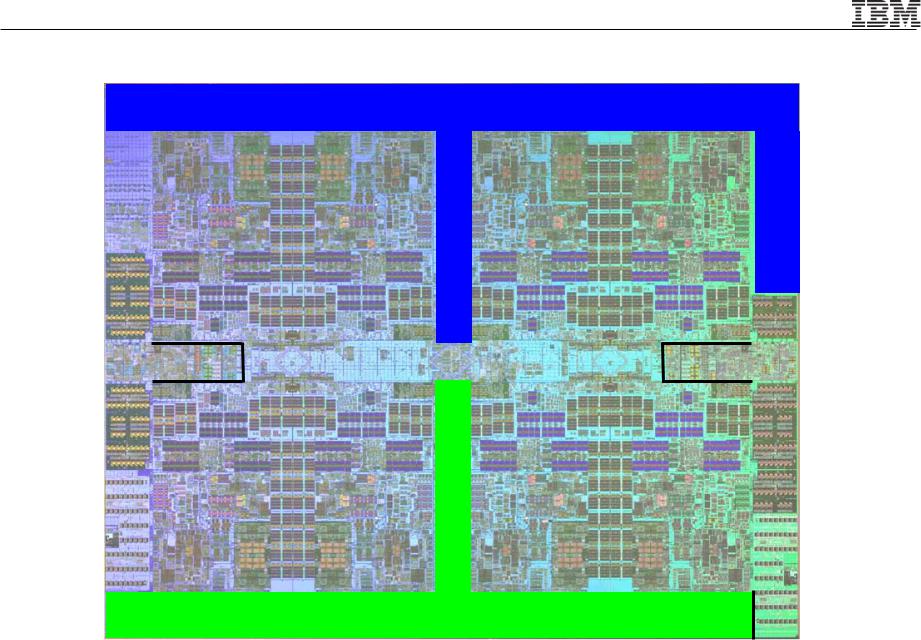
IBM Power Systems
Exploit Long Term Investment in Coherence Innovation
|
Core |
|
Core |
Local |
Core |
|
Core |
|
|
|
|
|
SMP |
|
|
|
|
|
L2 Cache |
|
L2 Cache |
Links |
L2 Cache |
|
L2 Cache |
|
|
|
|
|
|
|
|
|
|
|
|
|
|
|
|
|
|
|
|
|
|
|
|
|
|
|
|
|
|
|
|
|
|
|
|
|
Mem Ctrl |
L3 Cache and Chip Interconnect |
Mem Ctrl |
||||||
|
|
|
|
|
|
|
|
|
|
|
|
|
Remote |
|
|
|
|
|
L2 Cache |
|
L2 Cache |
L2 Cache |
|
L2 Cache |
|
|
|
|
+ SMP |
|
|
||||
|
|
|
|
|
|
|
|
|
|
Core |
|
Core |
Core |
|
Core |
|
|
|
|
Links I/O |
|
|
||||
|
|
|
|
|
|
|
|
|
|
|
|
|
|
|
|
|
|
Using local and remote SMP links, up to 32 POWER7 chips are connected
Power your planet
© 2010 IBM Corporation
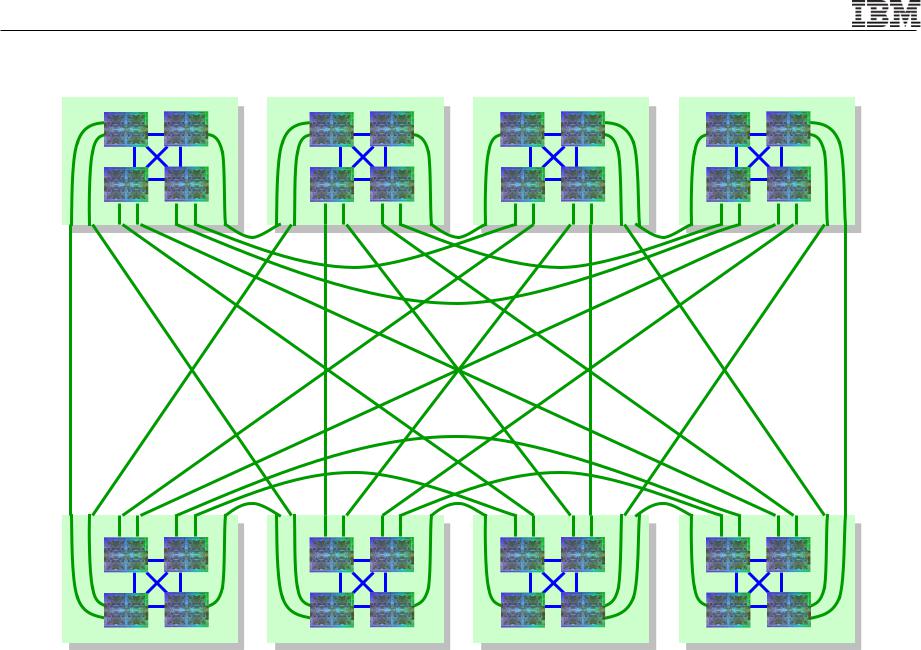
IBM Power Systems
Exploit Long Term Investment in Coherence Innovation
Up to 32 POWER7 chips form a massive SMP system.
Power your planet
*Statements regarding SMP servers do not imply that IBM will introduce
a system with this capability.
© 2010 IBM Corporation
